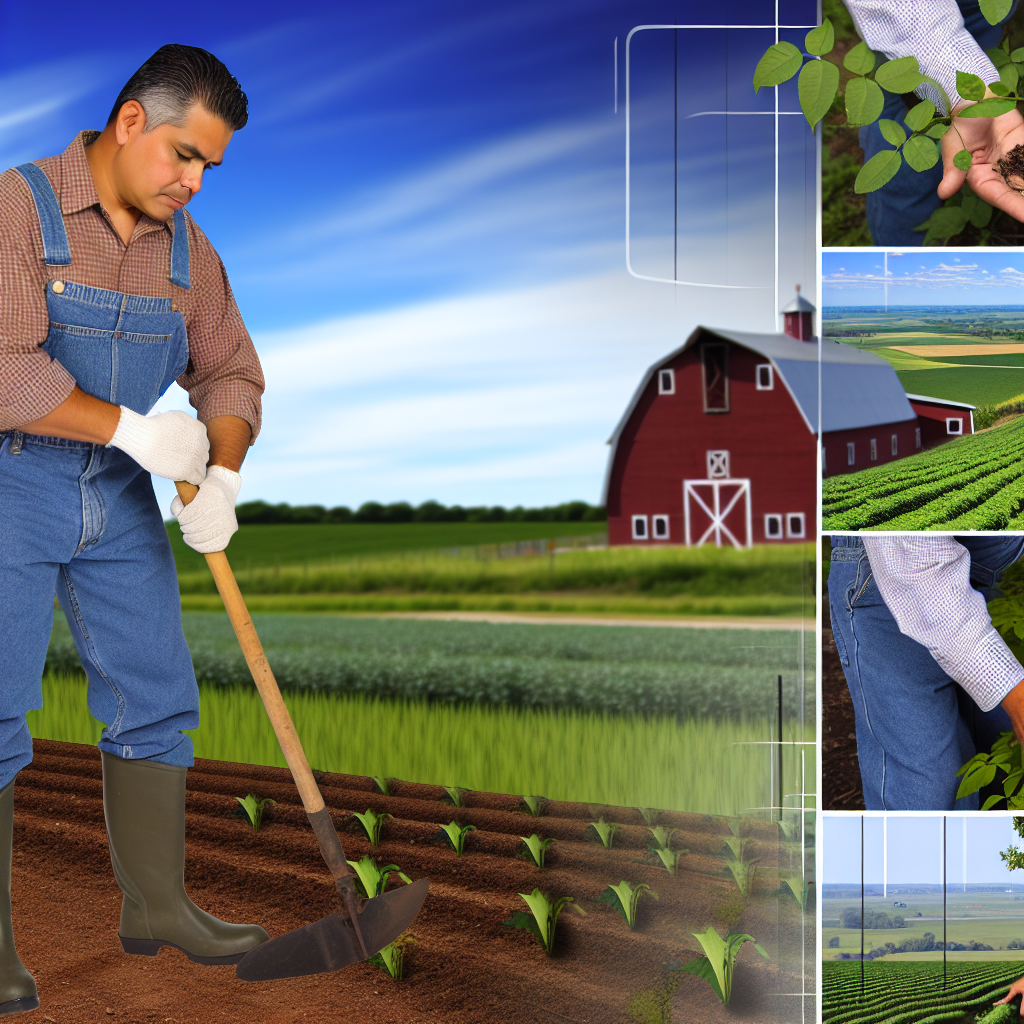Introduction to Carbon Sequestration
Carbon sequestration plays a vital role in combating climate change.
It involves capturing and storing atmospheric carbon dioxide.
Farmers can significantly contribute to this process through various techniques.
These methods not only help the environment but also benefit agriculture.
Importance of Carbon Sequestration in Agriculture
Carbon sequestration reduces the amount of CO2 in the atmosphere.
This reduction helps mitigate global warming effects.
Moreover, it enhances soil health and fertility.
Healthy soils can increase crop yields and agricultural sustainability.
Farmers adopting these practices often see improved productivity.
Benefits of Carbon Sequestration Techniques
Implementing carbon sequestration techniques offers multiple benefits.
First, these methods can improve soil structure and water retention.
This leads to healthier crops and reduced irrigation needs.
Second, carbon sequestration can provide additional income streams.
Farmers can sell carbon credits in many regions.
Lastly, sustainable practices increase resilience against climate extremes.
Transform Your Agribusiness
Unlock your farm's potential with expert advice tailored to your needs. Get actionable steps that drive real results.
Get StartedThis resilience is crucial for long-term agricultural viability.
Understanding Carbon Sequestration: Definitions and Key Concepts
Defining Carbon Sequestration
Carbon sequestration refers to the process of capturing and storing atmospheric carbon dioxide.
This process mitigates climate change by reducing greenhouse gas concentrations in the atmosphere.
Farmers can play a crucial role in carbon sequestration through various agricultural practices.
Types of Carbon Sequestration
Two main types of carbon sequestration exist: biological and geological.
Biological sequestration involves storing carbon in forests, soils, and oceans.
Geological sequestration involves injecting carbon dioxide into underground rock formations.
The Importance of Carbon Sequestration
Carbon sequestration benefits the environment significantly.
It helps mitigate the impacts of climate change by lowering atmospheric carbon levels.
Additionally, it enhances soil health and increases agricultural productivity.
Key Concepts in Carbon Sequestration
Understanding several key concepts is essential for effective carbon sequestration.
Soi organic carbon is a critical component of maintaining soil health.
Carbon cycling illustrates how carbon moves through the ecosystem.
Moreover, permanence highlights the need for long-term carbon storage solutions.
Challenges in Carbon Sequestration
Despite its benefits, carbon sequestration faces several challenges.
Measurement and verification of sequestered carbon can be complex.
Furthermore, agricultural practices must be adjusted to optimize carbon capture.
Lastly, promoting awareness among farmers about these techniques is crucial.
Top Techniques for Carbon Sequestration in Agriculture
Cover Cropping
Cover cropping involves planting specific crops during off-seasons.
These crops improve soil health and enhance carbon capture.
Furthermore, they prevent soil erosion and suppress weeds.
No-Till Farming
No-till farming reduces soil disruption and preserves carbon stocks.
This method fosters a healthy soil ecosystem and enhances nutrient cycling.
Moreover, it minimizes the release of carbon dioxide into the atmosphere.
Showcase Your Farming Business
Publish your professional farming services profile on our blog for a one-time fee of $200 and reach a dedicated audience of farmers and agribusiness owners.
Publish Your ProfileCrop Rotation
Crop rotation enhances soil fertility and promotes carbon sequestration.
Diverse crop types reduce pest pressure and improve resilience.
Additionally, it helps in breaking disease cycles and optimizing yields.
Aggressive Grazing Management
Proper grazing management increases soil organic matter levels.
This technique encourages grassland restoration and carbon storage.
Consequently, it enhances forage quality and livestock health.
Agroforestry Practices
Agroforestry integrates trees into agricultural landscapes for multiple benefits.
This practice improves biodiversity and provides habitat for wildlife.
Additionally, it sequesters carbon effectively within tree biomass.
Biochar Application
Biochar is produced by pyrolyzing organic materials in an oxygen-limited environment.
Applying biochar enhances soil fertility while sequestering carbon.
Furthermore, it improves water retention and access to nutrients.
Wetland Restoration
Restoring wetlands captures significant amounts of carbon over time.
These natural ecosystems also provide flood management and wildlife habitat.
Additionally, they improve water quality through nutrient filtration.
Utilization of Advanced Technologies
Farmers can implement precision agriculture technologies to enhance carbon sequestration.
These technologies optimize fertilizer use and reduce emissions.
Moreover, they enable better monitoring of soil health and carbon levels.
Uncover the Details: Adapting to Changing Weather Patterns: Climate-Smart Farming Solutions
Cover Cropping: Enhancing Soil Health and Carbon Storage
Introduction to Cover Cropping
Cover cropping is an essential practice in sustainable agriculture.
It involves planting crops specifically to cover the soil.
Farmers utilize these crops to improve soil quality.
This technique significantly increases carbon sequestration.
Benefits of Cover Cropping
Cover crops offer various benefits for soil health.
- They enhance soil structure and fertility.
- They reduce soil erosion and runoff.
- They suppress weeds competing for resources.
- They provide habitat for beneficial organisms.
Types of Cover Crops
Farmers can choose from several types of cover crops.
- Leguminous plants, like clover, enrich nitrogen levels.
- Cereal grains, such as rye, improve soil structure.
- Brassicas, like radishes, help break compacted soil.
Implementing a Cover Cropping System
To implement cover cropping, timing is crucial.
Farmers should plant cover crops during the off-season.
This timing allows crops to grow without competing with cash crops.
Proper termination is essential before planting cash crops.
Measuring Carbon Sequestration
Measuring the success of cover cropping is vital.
Farmers can analyze soil samples for organic carbon content.
Moreover, they can monitor crop yield improvements.
Challenges and Considerations
Despite its benefits, cover cropping presents challenges.
Finding suitable cover crops for specific climates can be difficult.
Farmers should also consider potential pests and diseases.
Additionally, adequate management practices must be in place.
Successful Case Studies
Many farmers have successfully implemented cover cropping.
For instance, a farm in Iowa increased soil carbon by 30%.
Similarly, a California vineyard reported enhanced soil microbial life.
These examples highlight the effectiveness of cover cropping.
Showcase Your Farming Business
Publish your professional farming services profile on our blog for a one-time fee of $200 and reach a dedicated audience of farmers and agribusiness owners.
Publish Your ProfileGain More Insights: The Unseen Threat: How Microclimates Are Changing the Way We Farm
No-Till Farming: Reducing Soil Disturbance and Increasing Carbon Retention
What is No-Till Farming?
No-till farming involves growing crops without disturbing the soil.
This method contrasts traditional farming techniques that require plowing.
Farmers leave the previous year’s crop residues on the field.
These residues play a crucial role in soil health and carbon storage.
Benefits of No-Till Farming
No-till farming significantly benefits carbon sequestration.
It reduces soil erosion, protecting soil quality and structure.
Moreover, it enhances moisture retention in the soil.
This practice leads to improved nutrient cycling within the ecosystem.
As a result, biodiversity in soil increases, benefiting overall farm productivity.
Impact on Carbon Retention
No-till practices help to significantly increase soil organic carbon levels.
Less soil disturbance maintains existing carbon pools in the ground.
Additionally, the accumulation of crop residues contributes to increased carbon storage.
This process mitigates greenhouse gas emissions from the agricultural sector.
Adopting No-Till Techniques
Transitioning to no-till farming requires careful planning.
Farmers need to consider a cover crop strategy for optimal benefits.
Utilizing cover crops helps to suppress weeds and improve soil health.
Moreover, farmers should gradually adjust their equipment for no-till practices.
Case Studies and Success Stories
Many farmers have successfully implemented no-till farming.
For example, Maria Lopez Farms adopted this technique five years ago.
Her carbon retention increased dramatically, improving soil quality.
Another instance is the Green Valley Collective, focusing on sustainability.
They have reported significant reductions in erosion and increased yields.
Challenges in No-Till Farming
Despite its advantages, no-till farming poses some challenges.
Initial transitioning may lead to increased weeds and pests.
Farmers may need to adjust their pest management strategies accordingly.
Moreover, some are concerned about the upfront cost of new equipment.
Looking Ahead
No-till farming is a vital approach for sustainable agriculture.
Its effectiveness in promoting carbon sequestration is undeniable.
As more farmers embrace this technique, the environmental benefits grow.
Ultimately, it fosters a healthier ecosystem and combats climate change.
Find Out More: The Surprising Effects of Rising Temperatures on Wheat Production
Agroforestry: Integrating Trees into Cropping Systems for Better Sequestration
Understanding Agroforestry
Agroforestry combines agriculture and forestry practices.
This technique enhances biodiversity while improving land health.
Farmers integrate trees alongside crops to maximize land use.
Additionally, agroforestry captures carbon dioxide effectively.
This process mitigates climate change impacts significantly.
Benefits of Agroforestry
Agroforestry offers numerous environmental benefits.
Firstly, it reduces soil erosion and enhances soil fertility.
Secondly, integrated tree cover improves water retention in soil.
Showcase Your Farming Business
Publish your professional farming services profile on our blog for a one-time fee of $200 and reach a dedicated audience of farmers and agribusiness owners.
Publish Your ProfileMoreover, diversifying crops ensures better pest control.
This technique provides farmers with additional income sources.
Implementing Agroforestry Practices
Farmers can adopt various agroforestry models.
- Alley cropping involves growing crops between rows of trees.
- Silvopasture integrates trees with grazing livestock.
- Forest farming allows for the cultivation of understory crops.
Each method can suit different agricultural landscapes.
Choosing Suitable Tree Species
Selecting the right tree species is crucial for success.
Farmers should consider local climate and soil conditions.
Native species often provide numerous ecological benefits.
Additionally, fast-growing trees help sequester carbon quickly.
Challenges in Agroforestry
Implementing agroforestry is not without challenges.
Initial investment costs may deter some farmers.
Moreover, knowledge gaps about agroforestry systems can hinder adoption.
Farmers require extensions and education on best practices.
Nevertheless, the long-term benefits outweigh the initial hurdles.
See Related Content: How Climate Change Is Affecting Your Food Supply
Managed Grazing: Improving Soil Carbon Through Rotational Grazing Practices
Understanding Managed Grazing
Managed grazing involves structured movements of livestock across pastures.
This practice enhances soil health and carbon sequestration.
Farmers can significantly improve their land’s productivity using this method.
Furthermore, it helps reduce overgrazing and soil erosion.
Benefits of Rotational Grazing
Rotational grazing offers several environmental and economic advantages.
- It enhances soil carbon storage over time.
- This method encourages deeper root growth in grasses.
- Improved biodiversity results from varied grazing patterns.
- Farmers experience increased forage quality and quantity.
Implementing Rotational Grazing
Establishing a rotational grazing system requires careful planning.
First, farmers should segment their pasture into smaller paddocks.
Next, they can determine how long to graze each area.
Monitoring pasture recovery time is essential for success.
Additionally, introducing diverse plant species can optimize benefits.
Challenges and Considerations
While rotational grazing has numerous benefits, challenges exist.
Farmers may face initial costs for fencing and water supply modification.
Also, weather patterns can impact grazing schedules.
Nonetheless, proper planning can help mitigate these challenges.
Examples of Successful Managed Grazing
Several farmers have successfully adopted managed grazing techniques.
For instance, Emily Carter of Cedar Hill Farm reports improved soil health.
She utilizes rotational grazing to enhance her land’s productive capacity.
Similarly, Tom Rodriguez of Green Pastures Ranch has seen remarkable results.
The diversity of plant life on his property has increased significantly.

Biochar: Utilizing Charcoal for Soil Enrichment and Carbon Capture
Overview of Biochar
Biochar is a stable form of charcoal created from organic materials.
Farmers can produce it through pyrolysis, a process that heats biomass in the absence of oxygen.
This technique not only reduces waste but also captures carbon dioxide.
Benefits of Biochar
Using biochar improves soil health significantly.
It enhances soil structure, increasing its ability to retain water.
This characteristic is particularly beneficial during droughts.
Additionally, biochar can improve nutrient availability in the soil.
Showcase Your Farming Business
Publish your professional farming services profile on our blog for a one-time fee of $200 and reach a dedicated audience of farmers and agribusiness owners.
Publish Your ProfileIt aids in reducing soil acidification, making it more fertile.
Environmental Impact
Biochar plays a crucial role in carbon sequestration.
By trapping carbon within the soil, it reduces greenhouse gas emissions.
This practice contributes to climate change mitigation efforts.
Implementation for Farmers
Farmers can implement biochar through local workshops.
Researching local resources for biomass is essential.
They can source materials like crop residues, wood chips, or manure.
Creating biochar should take place in controlled pyrolysis units.
Case Studies
Several farms have successfully integrated biochar into their practices.
For example, Green Acres Farm reported a 30% increase in crop yields after implementation.
Similarly, Sunny Fields Bakery credits biochar with significant improvements in soil health.
Future Directions in Sustainable Farming
Farmers interested in biochar should explore partnerships with local universities.
These collaborations can lead to further research and development.
Staying informed about new techniques and regulations is vital.
Ultimately, biochar presents a promising avenue for sustainable farming.
Best Practices for Implementing Carbon Sequestration Techniques on Farms
Soil Management Strategies
Effective soil management promotes carbon sequestration on farms.
Farmers should utilize cover crops to increase organic matter.
Additionally, practicing no-till farming can greatly benefit soil structure.
This method reduces soil disturbance, which helps retain carbon.
Regular soil testing also aids in understanding nutrient needs.
Agroforestry Methods
Agroforestry combines trees with crops or livestock effectively.
This technique enhances biodiversity while sequestering carbon.
Farmers should plant tree buffers along field edges for maximum benefit.
Moreover, integrating fruit or nut trees can provide economic value.
Pasture Management Practices
Improving pasture management enhances soil carbon storage effectively.
Rotational grazing helps prevent overgrazing and promotes plant health.
This method increases soil organic matter and supports wildlife.
Furthermore, using diverse plant species can improve resilience.
Use of Biochar
Biochar is a valuable tool for sequestering carbon in soil.
This stable form of carbon enhances soil fertility and structure.
Applying biochar also increases water retention in sandy soils.
Farmers can produce biochar from farm waste materials.
Continuous Learning and Adaptation
Farmers should commit to ongoing education about carbon practices.
Participating in workshops and networks fosters knowledge sharing.
Staying informed about new technologies can greatly enhance efforts.
Additionally, adapting to changing climate conditions is crucial.
Partnerships and Collaborations
Building partnerships with local organizations can amplify efforts.
Farmers should connect with conservation groups and research institutions.
Through collaboration, they can access resources and funding.
Joint initiatives can lead to greater impact on carbon sequestration.
Showcase Your Farming Business
Publish your professional farming services profile on our blog for a one-time fee of $200 and reach a dedicated audience of farmers and agribusiness owners.
Publish Your ProfilePotential Challenges and Solutions in Adopting Carbon Sequestration Methods
Understanding Barriers
Farmers face various barriers when adopting carbon sequestration techniques.
Financial constraints often limit their ability to invest in new technologies.
Additionally, a lack of information can result in uncertainty about best practices.
Moreover, policies and regulations may not support innovative approaches.
Weather variability also complicates implementation of these techniques.
Financial Challenges
High upfront costs pose a significant challenge for many farmers.
Funding opportunities may be limited in certain regions.
However, government grants can help alleviate these financial burdens.
Farmers can also explore partnerships with research institutions.
Investing in sustainable practices can lead to long-term savings.
Knowledge Gaps
A lack of understanding often hinders the adoption of carbon sequestration methods.
Farmers require access to comprehensive resources about these techniques.
Workshops and training sessions can bridge this knowledge gap.
Creating networks among farmers fosters sharing of successful practices.
Consulting with agronomists can provide tailored solutions for individual farms.
Policy and Regulatory Issues
Current agricultural policies may not incentivize carbon sequestration.
Advocacy for supportive legislation is crucial for effective implementation.
Farmers should engage with policymakers to promote beneficial changes.
Collaboration among stakeholders can lead to better regulatory frameworks.
Incentives for sustainable practices can drive widespread adoption.
Weather and Climate Variability
Climate change creates unpredictable growing conditions for farmers.
This variability may impact the effectiveness of sequestration techniques.
Diverse strategies can mitigate the effects of adverse weather.
Implementing robust soil health practices increases resilience.
Farmers can monitor weather patterns to adapt their methods swiftly.
The Future of Carbon Sequestration in Sustainable Farming
Emerging Techniques and Their Impact
Carbon sequestration methods are advancing rapidly in agriculture.
New techniques can significantly enhance soil health.
Innovative practices reduce atmospheric carbon levels.
Farmers are adopting technology like cover cropping and biochar.
Each technique builds organic matter and improves carbon storage.
Importance of Research and Development
Research plays a critical role in improving carbon sequestration methods.
Investments in agricultural science can drive solutions forward.
Universities and private sectors collaborate on effective practices.
Ongoing studies help tailor methods to various climates and soils.
Policy Support and Incentives
Government policies can protect and promote carbon farming.
Incentives for farmers encourage adoption of sustainable practices.
Successful programs exist in countries prioritizing environmental impact.
Localized support can help farmers implement new techniques.
Community Involvement and Education
Engaging local communities enhances knowledge sharing.
Workshops and training foster understanding of carbon farming.
Showcase Your Farming Business
Publish your professional farming services profile on our blog for a one-time fee of $200 and reach a dedicated audience of farmers and agribusiness owners.
Publish Your ProfileCultivating partnerships boosts resource accessibility.
Educated farmers are more likely to adopt beneficial techniques.
Looking Ahead: Agriculture’s Role in Climate Change
Sustainable farming methods can impact climate change positively.
Farmers are crucial players in the global effort to reduce carbon emissions.
Carbon sequestration opens doors to new agricultural markets.
The future of farming hinges on adopting eco-friendly practices.
By prioritizing carbon sequestration, agriculture can lead the way.
Additional Resources
Climate-Smart Agriculture and Forestry Resources | Farmers.gov
Soil Health, Soil Amendments, and Carbon Farming | USDA Climate …




